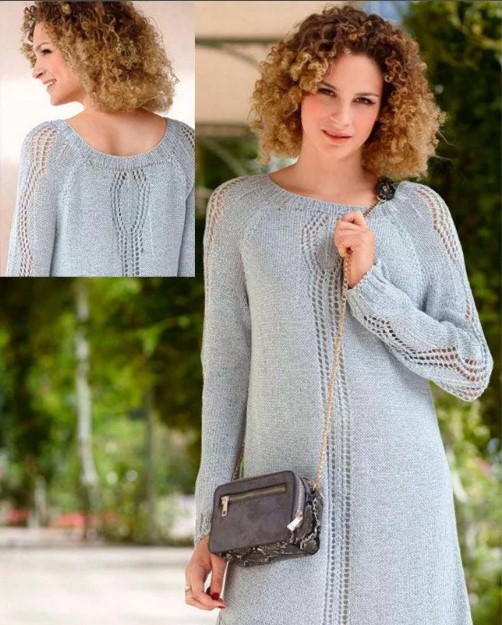 A very cozy and at the same time feminine item from a woman’s wardrobe is a dress. New models never cease to amaze craftsmen. There are only those that will suit the taste of real ladies - a high waist and a small flounce after the belt. You can additionally focus attention on the waist with a small pattern and a belt. More details about the most feminine model of a knitted dress with raglan, which is made on top, later in the article.
A very cozy and at the same time feminine item from a woman’s wardrobe is a dress. New models never cease to amaze craftsmen. There are only those that will suit the taste of real ladies - a high waist and a small flounce after the belt. You can additionally focus attention on the waist with a small pattern and a belt. More details about the most feminine model of a knitted dress with raglan, which is made on top, later in the article.
Taking measurements
To make a dress using the raglan technique it is important to correctly determine the circumference for the neckline.

Next, measure the length of the entire product. Measure the length for the sleeve separately to make 3/4. Waist and hip circumference. Measure your chest circumference. Separately measure the length of the raglan line, be sure to measure the length of the back.
Choosing yarn and knitting needles for a dress
Very often, yarn for women's dresses is used from a finer fiber. But not so thin that anything shows through the dense patterns. Medium thickness is also used to make models, but less frequently. The use of thick yarn for work has increased and this is due to new models that imply non-fitted shapes.
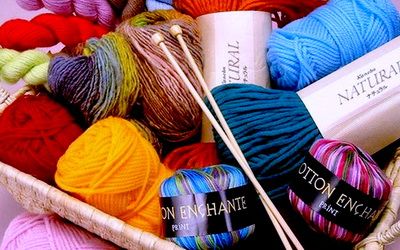
Important! A correctly selected dress in shape and knitting pattern will not flatter your figure. Some models generally look so miniature that a girl will become fragile and very tender in them.

Set of loops for 2 knitting needles
And depending on the season, dress for women can be done with woolen threads or with abundant artificial additives. But you should not use yarn that causes allergies on the delicate female body. And, just as important, the yarn should be pleasant to the body.
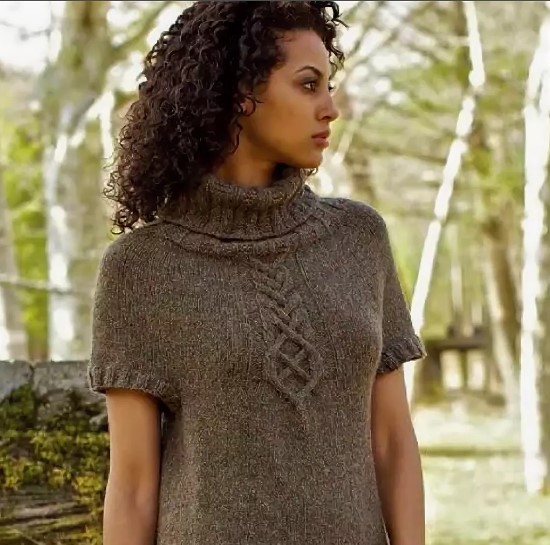
To work with such voluminous things that are made using the raglan technique, the master will choose circular knitting needles. Since it will be very difficult to knit a large and heavy product with simple straight knitting needles. Your hands will quickly get tired from such work.

On circular knitting needles there is no risk that stitches will get lost or your hands will quickly get tired under the weight of the fabric.
Calculation of the amount of yarn for a women's dress
You can calculate the amount of yarn two ways. The first provides availability of scales. You just need to knit a small sample and estimate how many of these you will need for the entire product. Next, the sample itself is weighed on a scale and later, using mathematical formulas, the total weight of the product is calculated. But for this you need to have good and accurate scales. Since an error of even a few grams will immediately spoil the accuracy of the calculation.

The second method does not require scales. Also knit a sample, and then compare how many such samples are needed for the whole dress. Then unravel the sample and measure the thread with which it was made. Next, calculate by length how many balls are needed. Each ball is always labeled with its length.
How to knit a women's dress with raglan knitting needles?
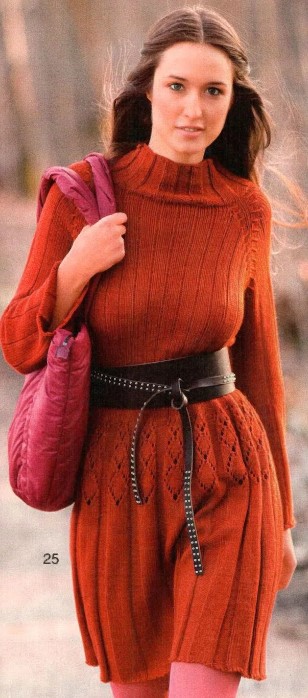 A raglan dress is the same blouse, but longer. To perform raglan on top, you need to start from the neckline. Very often it is knitted simply without changing the loops.
A raglan dress is the same blouse, but longer. To perform raglan on top, you need to start from the neckline. Very often it is knitted simply without changing the loops.
Next, the redistribution of loops begins and the most interesting moment begins - this is the raglan itself. You need to knit enough to get the desired width along the front and sleeves.
Additionally, after finishing the raglan, a set of loops occurs so as not to get an unpleasant hole in the armpit.
Then the division of labor, and the sleeves are separate from the shelves. Actually thisIt is easier to knit using this technique than using separate pieces. Since completely there may be a missing build step.
Next is a wonderful model that will clearly demonstrate how you can do an easy job and at the same time elegant.
Elegant red knitted dress with braids
 This model is created thanks to the raglan top. Braids just perfect for this model. It is thanks to such an interesting motif in the center of the front shelf that the master does not have to make a single reduction to obtain a fitted model.
This model is created thanks to the raglan top. Braids just perfect for this model. It is thanks to such an interesting motif in the center of the front shelf that the master does not have to make a single reduction to obtain a fitted model.
For work use:
- red yarn (wine color is possible);
- knitting needles for red yarn.
Measurements
Measure the length of the back of the model. Then the width of the back, the length for the 3/4 sleeves, the length of the hem from the waist line. And the most important thing is to measure the neck circumference correctly.
For this model, you can simply measure your head circumference and use that measurement.
Sample
Knit a sample for such a model, but, what is most interesting, use a non-knit stitch for it, which takes up more space on the entire fabric. Measure the knitting density for the resulting sample, and calculate how many loops are required for the initial set of loops around the neck circumference.

Facial surface
Neck elastic
Neck elastic done from the 2*2 elastic pattern. Knit only 10 rows of such elastic, and without changing the number of loops, immediately redistribute the loops for the sleeves and fronts. Knit with appropriate additions.
 Raglan
Raglan
For a soft transition and a beautiful raglan, make it in place of the continuation of the strip of facial loops of the elastic band. To do this, add not 1 loop, but 2 on each side of such a strip.
Immediately distribute a beautiful pattern with pigtails along the front shelf and fancy weave in the form of honeycombs. Knit the raglan itself to the desired length.

Honeycomb pattern
Shelves
Without changing the patterns and number of loops, combine only two shelves into a circle, and continue knitting in circular rows. Leave the sleeves aside for now. For a smooth transition, you can cast on a few loops for the inside of the sleeve. Knit to the waist line and change the braids to a simple stockinette stitch.

Hem
For the hem, only facial surface. Knit to the required length and calculate carefully, since The elastic band should still fit at the bottom. For elastic, use a length of at least 10 cmto get such a wide and even strip. It is very important that the number of loops does not change. The slight narrowing at the bottom is due only to the transition from the front surface, which always spreads well to elastic band 1*1.

Sleeves
Also use for sleeves facial surface and at the end, do the same as for the hem with an elastic band 10 cm wide. For sleeves use elastic band 1*1 knitting needles. It is better to close the loops using a special elastic method of closing loops.
Important! To make the sleeves neat, you should add additional loops from the inside, but you should not make them very wide.
So the chic dress is ready. It does not require assembly or other seams.
Patterns (schemes) for dresses
It is very important to choose good schemes for future work. The most popular patterns for dresses and other items are definitely braids and aranas.
 Diamonds have not gone out of fashion and are very beautiful now.
Diamonds have not gone out of fashion and are very beautiful now.

A good feed is obtained when using leaves for work.

A very, very popular pattern is cute Christmas trees. In fact, all the same braids, but in a new interpretation.
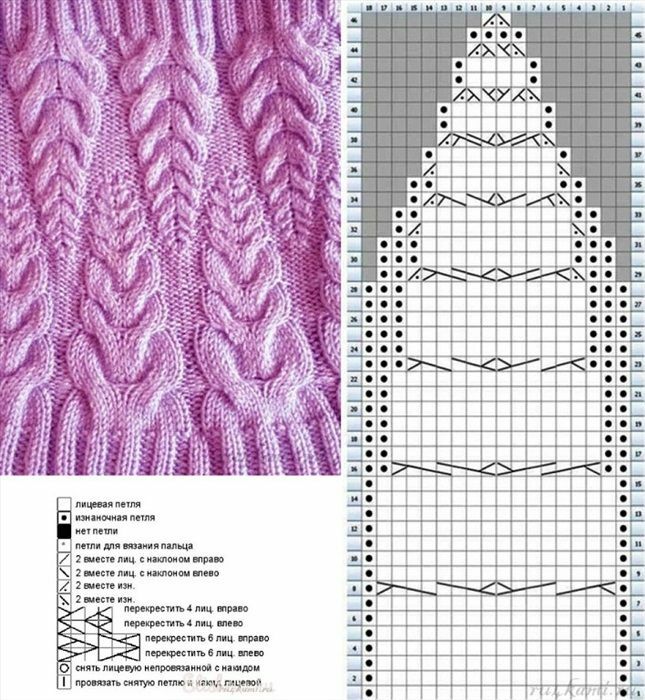
For a summer dress, a motif with numerous capes is good.

A sea of beautiful patterns and patterns exists and new ones are appearing. Masters will never stop creating something new. Therefore, we are joining in with all those who know how and want to knit. Talent should not be abandoned. Especially for those for whom it has grown into a favorite hobby.


 0
0





